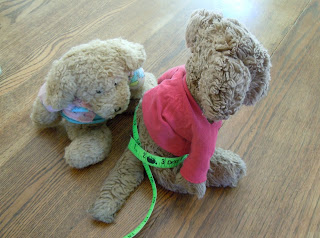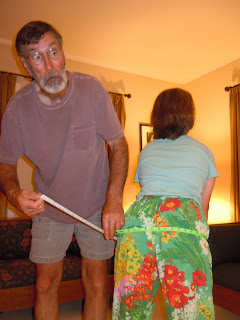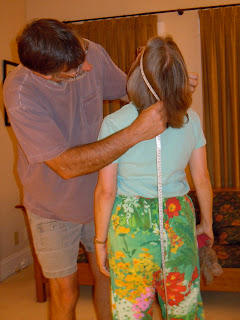When I first found out there were tests to determine one’s fat percentage, I was interested. Who wouldn’t want to know how marbled they are? People love to put numbers on stuff. At the time, there were a couple ways of going about it. Someone could measure you with calipers in certain key spots, like the mid-rib tickle zone and the upper arm wobbletorium. As long as they stayed away from my neck, which is where I store my chins, I figured I’d come out all right.
Then there was also the dunking technique, whereby the amount of water you displaced and the amount you weigh could be wrangled into a useful fat-to-muscle ratio. Muscle weighs more than the same volume of fat. As a side note, pizza and beer make you really, really strong.
Both of these methods seemed likely to produce meaningful numbers. I never did either one of them. But no one does anymore. For years they’ve been using the Body Mass Index. It’s entirely a function of your height and weight. That’s all. It gets you nowhere other than to let you know if you’re too short for your weight, which you knew anyway. It just gives you another number, which you can compare to a chart to determine where you stand on the spectrum between Attractive and Dead. All the recommended healthy weight charts top out an inch before Dave’s height, so he’s not on the graph, and has interpreted that to mean he can weigh whatever he wants to, since his mom told him not to extrapolate right after a meal.
But the BMI is almost useless, except to those without access to a mirror. It would lead a slight stringy woman who happens to have hooters cantilevered out to Kingdom Come to believe she needs to diet, when all she really needs is bigger feet and a counterweight.
The index (your weight divided by your height, squared) was invented by a Belgian guy between 1830 and 1850. Took him twenty years to come up with it. He knew he was onto something with the height and weight, and he just couldn’t come up with that final piece, squaring the height, when he was essentially dealing with roundness.
Anyway, I was pleased to learn that now there is a Body Adiposity Index. And it gets right to the heart of the issue, which is the butt. All it cares about is your fanny volume and your height. To get your BAI, you need to measure your can with a centimeter tape. (You don’t have one. They’re made for European people, who are smaller.)
Your BAI is your butt measurement divided by your height multiplied by the square root of your height, minus eighteen. What’s the eighteen for? I don’t know, but I will divulge that when we were working in the chemistry labs, sometimes we’d have to put in a number like that just to get the experiment to come out right. It’s a fudge factor, or something a lot like fudge. You want the experiment to come out right, don’t you?
The article I read said you need to get a partner to wrap the centimeter tape (which you don’t have one of) around you. Stop right there. The test starts out by assuming you can’t find your own ass with both hands. Here’s a tip: if it takes more than one person to measure around your butt, you could stand to drop a few pounds.



Lots of laughter here. And I love your final tip. However I firmly believe that lots of our politicians (regardless of their girth) would be unable to find their butts without the assistance of a third party. So perhaps this test is designed for politicians and others who are equally out of touch with the real world (and their behinds).
I just got one of those test run and am down to a dangerously low 65 percent. I wasn't about to let them measure my head. Let's just say the acoustics in there are awesome.
Wonderful post, Murr. Sounds like everyone used "Cook's Constant" to get through physics and chemistry labs.
Forget BMI and all the rest. Here is what one of my kids posted from an old NY times. http://www.nytimes.com/2008/08/19/health/19well.html
Better fat and fit than thin and not. Since I am fat and not, I am in trouble. Wife says lets go up stairs and make love, I tell her make up your mind I don't have the energy for both.
I love that first picture of Pootie and friend. Then that picture of your tush being measured and Dave's expression. You do know how to make my day, Murr, and I am now smiling ear to ear.
Fanny volume and height works for me, as long as tummy volume is somehow ignored. And I'm sure that the "18" is a variable subject to change to meet individual needs.
Another delightful post that starts my day chuckling.
Roxie sez
Oh my, I'll need as sliding scale as I am laughing my ass off here! I love you!
And I thought BMI stood for Bear Mass Indeed. We Bears don't much worry about our mass, because it changes a lot between fall and spring.
I always knew Humans had some kind of fascination with weight and numbers; now I've got the proof.
I'd like to recognize The Elephant's Child right now for almost always being the first person to comment here. I think she's in the time zone that comes just before anything actually happens. El, who's going to win the World Series?
And thanks, DJan, for recognizing Pootie from the rear. It's not his most flattering angle. That's his best bud, Hajerle, there.
According to my Doctor's interpretation of my BMI, I am the exactly correct weight for a man of my height. (Carrying an upright piano….)
Murr…..you are brilliant……a gift from the gods…….made my day with this one.
Centimeter tape, square roots…just give me the fudge, let me sit on the couch and enjoy.
Did someone put Miracle Gro on your pants? They rock my world. But maybe next time you should wear black. I hear it's more slimming.
Oh no, darling, I produce my own fertilizer.
Pretty sure my BAI is in line with the expected norms, but I still can't find it with both hands some days.
These pictures are so cute! I'm in big big trouble when it comes to the Body Adiposity Index. BIG trouble!
Still laughing…that's way too much math for me. You talk square roots and my eyes glaze over. I can however measure my butt by myself – and I have a centimeter tape.
Well, my butt is small but the belly…well, don't go there!!!
Love that Pootie and Dave have the same expression on their faces! And I hate these tests. They always make me feel like Gimli, son of Gloin in LOTR.
Hell, I was just coming to terms with my BMI, and now I have something else to rationalize. I guess I'll have to get one of those calculator apps for my phone…or maybe I could just find one that tells me how guilty to feel.
Laughing too hard to find my skinny ass, which I'll go on record as saying is the only skinny part of me.
Choice!
ROFL!!!
I've got tears in my eyes and actually had to go to the bathroom to avoid an accident! You definitely have a way with words! :p
OMG! Bigger feet and a counterweight! You are too funny.
Simply hilarious!
Hey Brewster. There's this old fashioned thingy you might be interested in. You can still get theme at the drug store. It's called a scale!!
I can't find my way about my arse without an atlas, so perhaps they're trying to tell me something. And as a Brit (technically a European, but we'd rather not be) I like old fashioned feet and inches. So clearly I'm overweight anyway. Damn. Indigo
My problem with the BMI calculation is that it leaves out one very important variable – AGE! According to the BMI your body mass should be exactly the same when you were 32 as 62. Just like economists adjust for inflation, the BMI should adjust for … Inflation. Until they do that, I dismiss the BMI as a measurement relevant only for anyone under the age of 30
I've never taken much notice of my BMI. I use a simpler method. I just figure if there's a bit too much wobble and flab around the place, I should cut down my portion sizes.
After a few beers, which are mostly protein, my BMI goes up, but I look better.
I was in charge of an office renovation once. We installed some cubicles with larger-than-standard entrance openings (3 feet wide). A staffperson came to me to tell me she did not think that would be wide enough for her as she had a big butt (and I cannot lie). So I hauled out my tape and measured her ass. 3 years later, I am still laughing.
more info on body mass index here – Body Adiposity Index (BAI) Better Than Body Mass Index (BMI)
Vivi Rrr likes this.
LOL at the counterweight.